Microstructural Evolution of High-Entropy Intermetallic Compounds during Detonation Spraying
Abstract
:1. Introduction
2. Materials and Methods
2.1. Synthesis of HEIC Powders
2.2. DS Coating
2.3. Characterization
3. Results and Discussion
3.1. Microstructure of HEICs
3.2. DS Coatings
4. Conclusions
- The as-cast (NbTaVCrTi)Al3, (NbTaVNiFe)Al3, and (NbTaVZrHf)Al3 indicated clear segregation with a nearly single D022 (TaAl3 type) structure, while (FeNiCoCrMn)(MoCr) exhibited a lower degree of segregation and a single D8b (FeCr type) structure;
- In all HEICs, Nb and Ta segregated together in the dendritic arms, which could be attributed to their higher melting points compared to other constituent elements. The segregation of other elements could be also described by the corresponding enthalpy of mixing of binary pairs;
- All the HEIC coatings fabricated by detonation spraying retained their crystal structures and exhibited a dense lamellar microstructure consisting of different features and segregated regions with oxide particles embedded. All the coatings indicated sound bonding with the substrate and a low level of porosity;
- (FeNiCoCrMn)(MoCr) exhibited the highest microhardness values of 1047 HV among all the HEIC coatings. The microhardness values were 745 HV for (NbTaVCrTi)Al3, 753 HV for (NbTaVNiFe)Al3, and 862 HV for (NbTaVZrHf)Al3.
Author Contributions
Funding
Data Availability Statement
Conflicts of Interest
References
- Coury, F.G.; Zepon, G.; Bolfarini, C. Multi-principal element alloys from the CrCoNi family: Outlook and perspectives. J. Mater. Res. Technol. 2021, 15, 3461–3480. [Google Scholar] [CrossRef]
- Liu, D.; Yu, Q.; Kabra, S.; Jiang, M.; Forna-Kreutzer, P.; Zhang, R.; Payne, M.; Walsh, F.; Gludovatz, B.; Asta, M. Exceptional fracture toughness of CrCoNi-based medium-and high-entropy alloys at 20 kelvin. Science 2022, 378, 978–983. [Google Scholar] [CrossRef] [PubMed]
- Gu, G.H.; Kwon, H.; Kim, Y.; Haftlang, F.; Heo, Y.-U.; Kim, H.S. Unprecedented bake hardening responses of interstitial high-entropy alloy by synergistic effect with lattice distortion. Mater. Des. 2023, 233, 112289. [Google Scholar] [CrossRef]
- Lin, C.; Yao, Y. Corrosion-Resistant Coating Based on High-Entropy Alloys. Metals 2023, 13, 205. [Google Scholar] [CrossRef]
- Wang, M.; Lu, Y.; Lan, J.; Wang, T.; Zhang, C.; Cao, Z.; Li, T.; Liaw, P.K. Lightweight, ultrastrong and high thermal-stable eutectic high-entropy alloys for elevated-temperature applications. Acta Mater. 2023, 248, 118806. [Google Scholar] [CrossRef]
- Toher, C.; Oses, C.; Esters, M.; Hicks, D.; Kotsonis, G.N.; Rost, C.M.; Brenner, D.W.; Maria, J.-P.; Curtarolo, S. High-entropy ceramics: Propelling applications through disorder. MRS Bull. 2022, 47, 194–202. [Google Scholar] [CrossRef]
- Zhang, L.; Zhang, J.; Wang, X.; Tao, M.; Dai, G.; Wu, J.; Miao, Z.; Han, S.; Yu, H.; Lin, X. Design of coherent wideband radiation process in a Nd3+-doped high entropy glass system. Light Sci. Appl. 2022, 11, 181. [Google Scholar] [CrossRef] [PubMed]
- Duan, K.; Liu, L.; Yao, K.; Zhang, X.; Liu, B.; Qi, J.; Chen, M.; Zhao, R.; Wu, F. High-entropy intermetallics with striking high strength and thermal stability. Mater. Lett. 2022, 321, 132424. [Google Scholar] [CrossRef]
- Yang, T.; Cao, B.; Zhang, T.; Zhao, Y.; Liu, W.; Kong, H.; Luan, J.; Kai, J.; Kuo, W.; Liu, C. Chemically complex intermetallic alloys: A new frontier for innovative structural materials. Mater. Today 2022, 52, 161–174. [Google Scholar] [CrossRef]
- Moghaddam, A.O.; Fereidonnejad, R.; Cabot, A. Semi-ordered high entropy materials: The case of high entropy intermetallic compounds. J. Alloys Compd. 2023, 960, 170802. [Google Scholar] [CrossRef]
- Meng, Y.; Duan, F.; Pan, J.; Li, Y. Phase stability of B2-ordered ZrTiHfCuNiFe high entropy alloy. Intermetallics 2019, 111, 106515. [Google Scholar] [CrossRef]
- Yao, K.; Liu, L.; Ren, J.; Guo, Y.; Liu, Y.; Cao, Y.; Feng, R.; Wu, F.; Qi, J.; Luo, J. High-entropy intermetallic compound with ultra-high strength and thermal stability. Scr. Mater. 2021, 194, 113674. [Google Scholar] [CrossRef]
- He, Q.; Wang, J.; Chen, H.; Ding, Z.; Zhou, Z.; Xiong, L.; Luan, J.; Pelletier, J.; Qiao, J.; Wang, Q. A highly distorted ultraelastic chemically complex Elinvar alloy. Nature 2022, 602, 251–257. [Google Scholar] [CrossRef] [PubMed]
- Ye, Z.; Li, C.; Zheng, M.; Zhang, X.; Yang, X.; Wang, Q.; Gu, J. Realizing superior strength-ductility combination in dual-phase AlFeCoNiV high-entropy alloy through composition and microstructure design. Mater. Res. Lett. 2022, 10, 736–743. [Google Scholar] [CrossRef]
- Yang, T.; Zhao, Y.; Li, W.; Yu, C.; Luan, J.; Lin, D.; Fan, L.; Jiao, Z.; Liu, W.; Liu, X. Ultrahigh-strength and ductile superlattice alloys with nanoscale disordered interfaces. Science 2020, 369, 427–432. [Google Scholar] [CrossRef] [PubMed]
- Xiao, B.; Zhang, J.; Liu, S.; Zhou, Y.; Ju, J.; Kai, J.-J.; Zhao, Y.; Yang, X.; Xu, L.; Zhao, S. Ultrahigh intermediate-temperature strength and good tensile plasticity in chemically complex intermetallic alloys via lamellar architectures. Acta Mater. 2023, 262, 119459. [Google Scholar] [CrossRef]
- Meghwal, A.; Anupam, A.; Murty, B.; Berndt, C.C.; Kottada, R.S.; Ang, A.S.M. Thermal spray high-entropy alloy coatings: A review. J. Therm. Spray Technol. 2020, 29, 857–893. [Google Scholar] [CrossRef]
- Nair, R.B.; Supekar, R.; Javid, S.M.; Wang, W.; Zou, Y.; McDonald, A.; Mostaghimi, J.; Stoyanov, P. High-Entropy Alloy Coatings Deposited by Thermal Spraying: A Review of Strengthening Mechanisms. Performance Assessments and Perspectives on Future Applications. Metals 2023, 13, 579. [Google Scholar] [CrossRef]
- Wang, L.; Zhang, F.; Ma, H.; He, S.; Yin, F. Microstructure evolution and mechanical properties of plasma sprayed AlCoCrFeNi2. 1 eutectic high-entropy alloy coatings. Surf. Coat. Technol. 2023, 471, 129924. [Google Scholar] [CrossRef]
- Silvello, A.; Diaz, E.T.; Ramirez, E.R.; Cano, I.G. Microstructural, Mechanical and Wear Properties of Atmospheric Plasma-Sprayed and High-Velocity Oxy-Fuel AlCoCrFeNi Equiatomic High-Entropy Alloys (HEAs) Coatings. J. Therm. Spray Technol. 2023, 32, 425–442. [Google Scholar] [CrossRef]
- Liao, W.-B.; Wu, Z.-X.; Lu, W.; He, M.; Wang, T.; Guo, Z.; Huang, J. Microstructures and mechanical properties of CoCrFeNiMn high-entropy alloy coatings by detonation spraying. Intermetallics 2021, 132, 107138. [Google Scholar] [CrossRef]
- Zhao, P.; Zhu, J.; Yang, K.; Li, M.; Shao, G.; Lu, H.; Ma, Z.; Wang, H.; He, J. Outstanding wear resistance of plasma sprayed high-entropy monoboride composite coating by inducing phase structural cooperative mechanism. Appl. Surf. Sci. 2023, 616, 156516. [Google Scholar] [CrossRef]
- Wang, K.; Zhu, J.; Wang, H.; Yang, K.; Zhu, Y.; Qing, Y.; Ma, Z.; Gao, L.; Liu, Y.; Wei, S. Air plasma-sprayed high-entropy (Y0.2Yb0.2Lu0.2Eu0.2Er0.2)3Al5O12 coating with high thermal protection performance. J. Adv. Ceram. 2022, 11, 1571–1582. [Google Scholar] [CrossRef]
- Supekar, R.; Nair, R.B.; McDonald, A.; Stoyanov, P. Sliding wear behavior of high entropy alloy coatings deposited through cold spraying and flame spraying: A comparative assessment. Wear 2023, 516, 204596. [Google Scholar] [CrossRef]
- Preuß, B.; Lindner, T.; Kaur, S.; Cabrera, J.E.T.; Hanisch, N.; Schwarz, H.; Lampke, T. Development of CoCr0.65FeNi-BSiC as a self-fluxing high-entropy alloy for thermal spraying. Surf. Coat. Technol. 2023, 476, 130259. [Google Scholar] [CrossRef]
- Pal, S.; Nair, R.B.; McDonald, A. Effect of tungsten and vanadium additions on the dry abrasive wear and solid particle erosion of flame-sprayed AlCoCrFeMo high entropy alloy coatings. Int. J. Refract. Met. Hard Mater. 2023, 114, 106245. [Google Scholar] [CrossRef]
- Lu, J.; Chen, Y.; Li, L.; Zhang, H.; Zhang, X.; Zhao, X. An in-situ oxide-dispersion-strengthened AlCoCrFeNiY high-entropy alloy composite coating prepared by AC-HVAF with superior oxidation and spallation resistance. Compos. Part B Eng. 2023, 265, 110933. [Google Scholar] [CrossRef]
- Sfikas, A.K.; Kamnis, S.; Tse, M.C.; Christofidou, K.A.; Gonzalez, S.; Karantzalis, A.E.; Georgatis, E. Microstructural Evaluation of Thermal-Sprayed CoCrFeMnNi0. 8V High-Entropy Alloy Coatings. Coatings 2023, 13, 1004. [Google Scholar] [CrossRef]
- Wu, Z.-X.; He, M.-J.; Feng, C.-S.; Wang, T.-L.; Lin, M.-Z.; Liao, W.-B. Effects of Annealing on the Microstructures and Wear Resistance of CoCrFeNiMn High-Entropy Alloy Coatings. J. Therm. Spray Technol. 2022, 31, 1244–1251. [Google Scholar] [CrossRef]
- Batraev, I.; Dudina, D.V.; Rybin, D.K.; Ulianitsky, V.Y.; Sova, A.; Moghaddam, A.O.; Doubenskaia, M.; Trofimov, E.; Samodurova, M. High-entropy alloy coating deposition by detonation spraying combined with heat treatment. Int. J. Adv. Manuf. Technol. 2023, 129, 2647–2659. [Google Scholar] [CrossRef]
- Moghaddam, A.O.; Samodurova, M.; Mikhailov, D.; Trofimov, E. High entropy intermetallic coatings fabricated by detonation spraying. Mater. Lett. 2022, 311, 131560. [Google Scholar] [CrossRef]
- Moghaddam, A.O.; Abdollahzadeh, A.; Samodurova, M.; Shaburova, N.; Mikhailov, D.; Fereidonnejad, R.; Zhivulin, V.; Trofimov, E. Novel high entropy intermetallic compounds: Synthesis and detonation spraying. Intermetallics 2022, 146, 107591. [Google Scholar] [CrossRef]
- Moghaddam, A.O.; Shaburova, N.; Naseri, M.; Latfulina, Y.; Samodurova, M.; Krymsky, V.; Litvinyuk, K.; Trofimov, E. Detonation Spraying of Ni-Based Composite Coatings Reinforced by High-Entropy Intermetallic Particles. Metals 2023, 13, 1807. [Google Scholar] [CrossRef]
- Takeuchi, A.; Inoue, A. Classification of bulk metallic glasses by atomic size difference. heat of mixing and period of constituent elements and its application to characterization of the main alloying element. Mater. Trans. 2005, 46, 2817–2829. [Google Scholar] [CrossRef]
- Samoilova, O.; Shaburova, N.; Samodurova, M.; Pashkeev, K.; Moghaddam, A.O.; Trofimov, E. Microstructure and Wear Behavior of Al0.25CoCrFeNiSi0.6 High-Entropy Alloy Coating Deposited on Stainless Steel by Detonation Spraying. J. Therm. Spray Technol. 2023, 32, 1220–1229. [Google Scholar] [CrossRef]
- Talib, R.; Saad, S.; Toff, M.; Hashim, H. Thermal spray coating technology: A review. Solid State Sci. Technol. 2003, 11, 109–117. [Google Scholar]
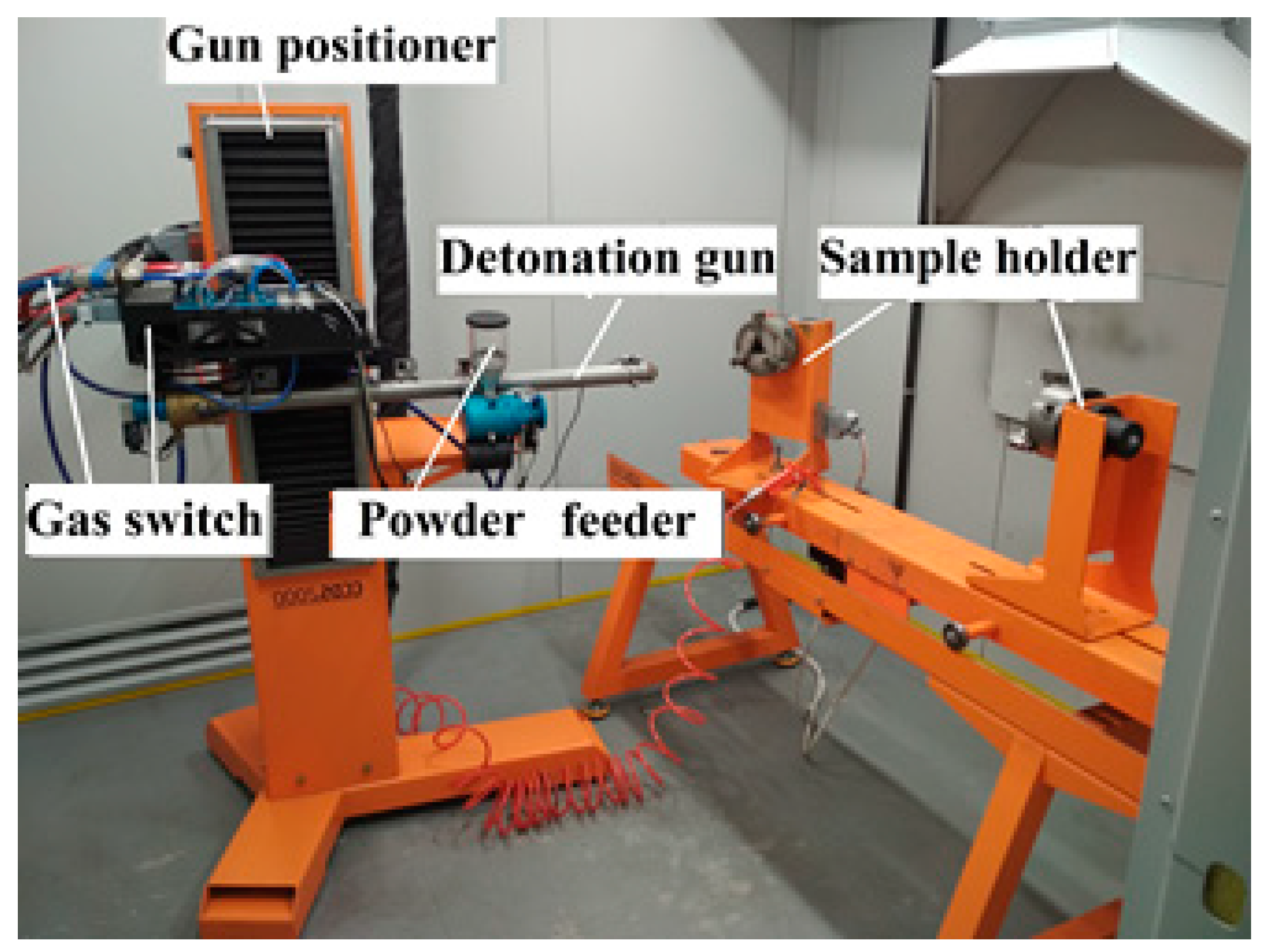

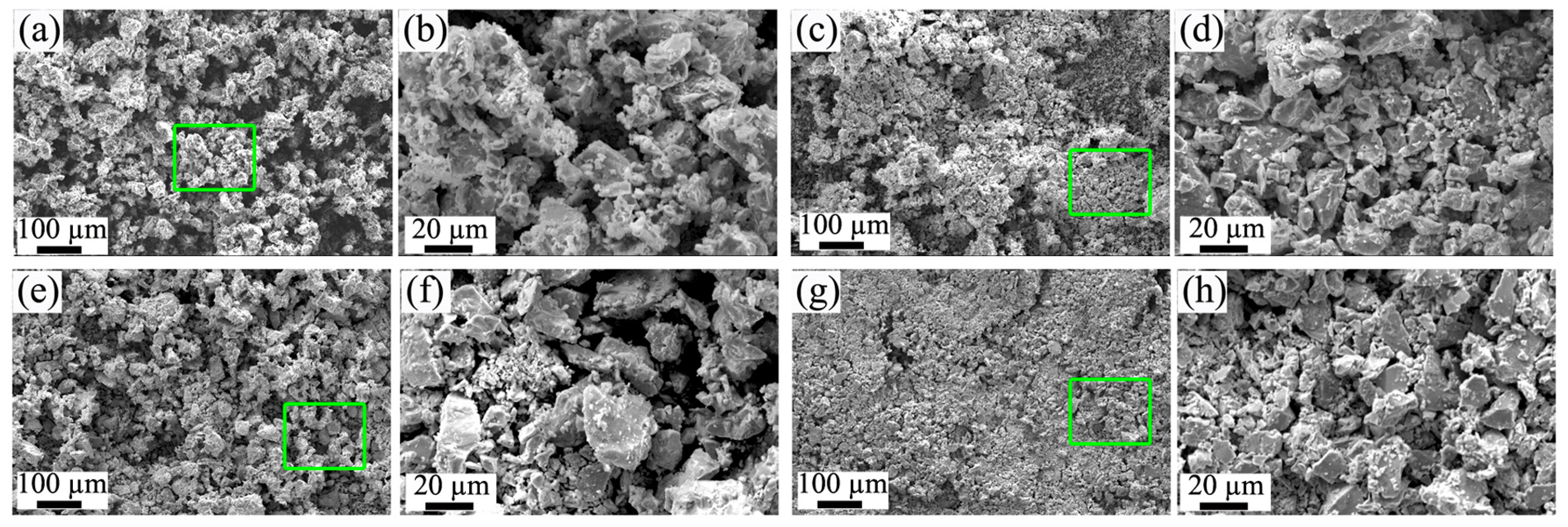
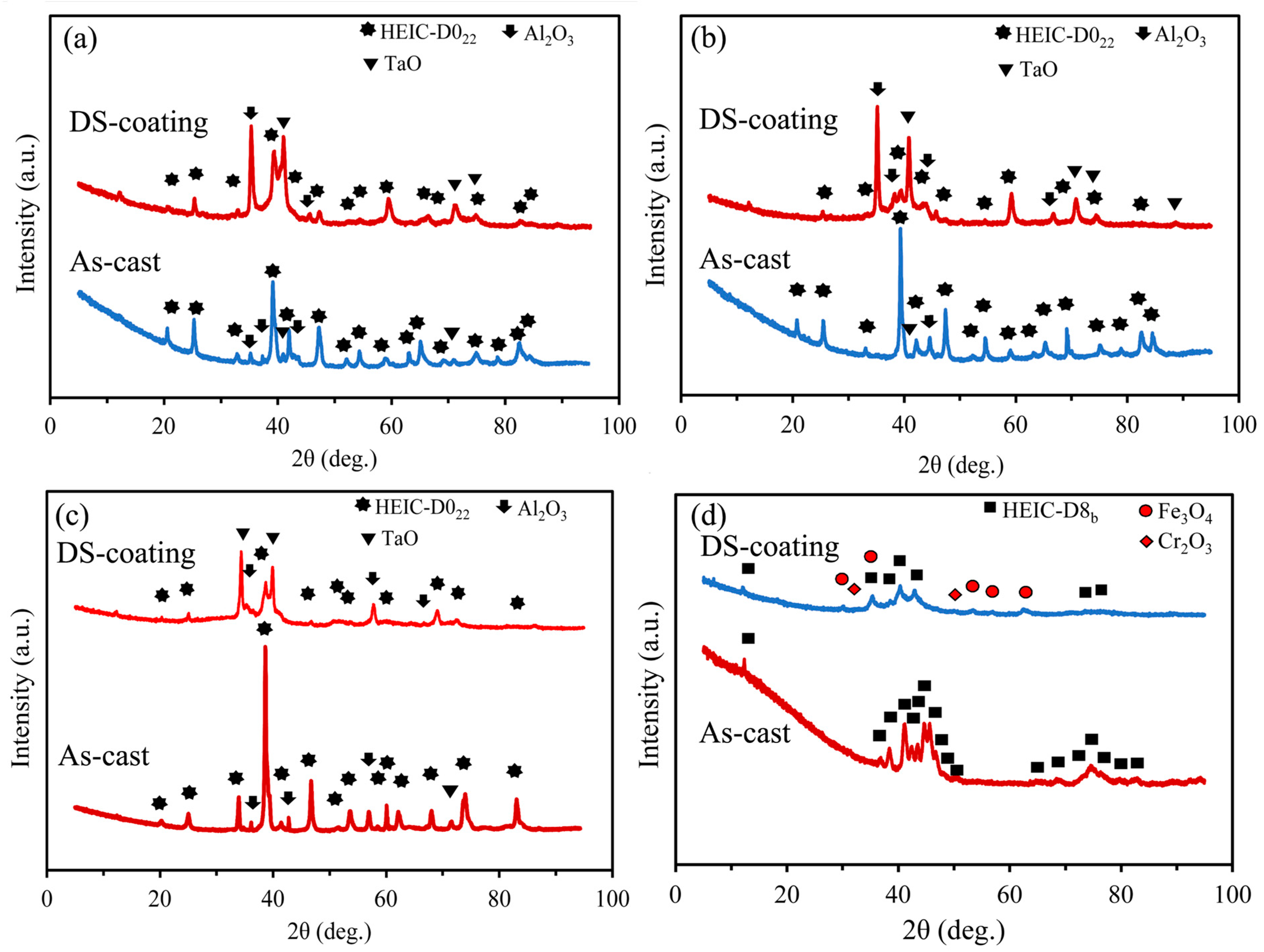

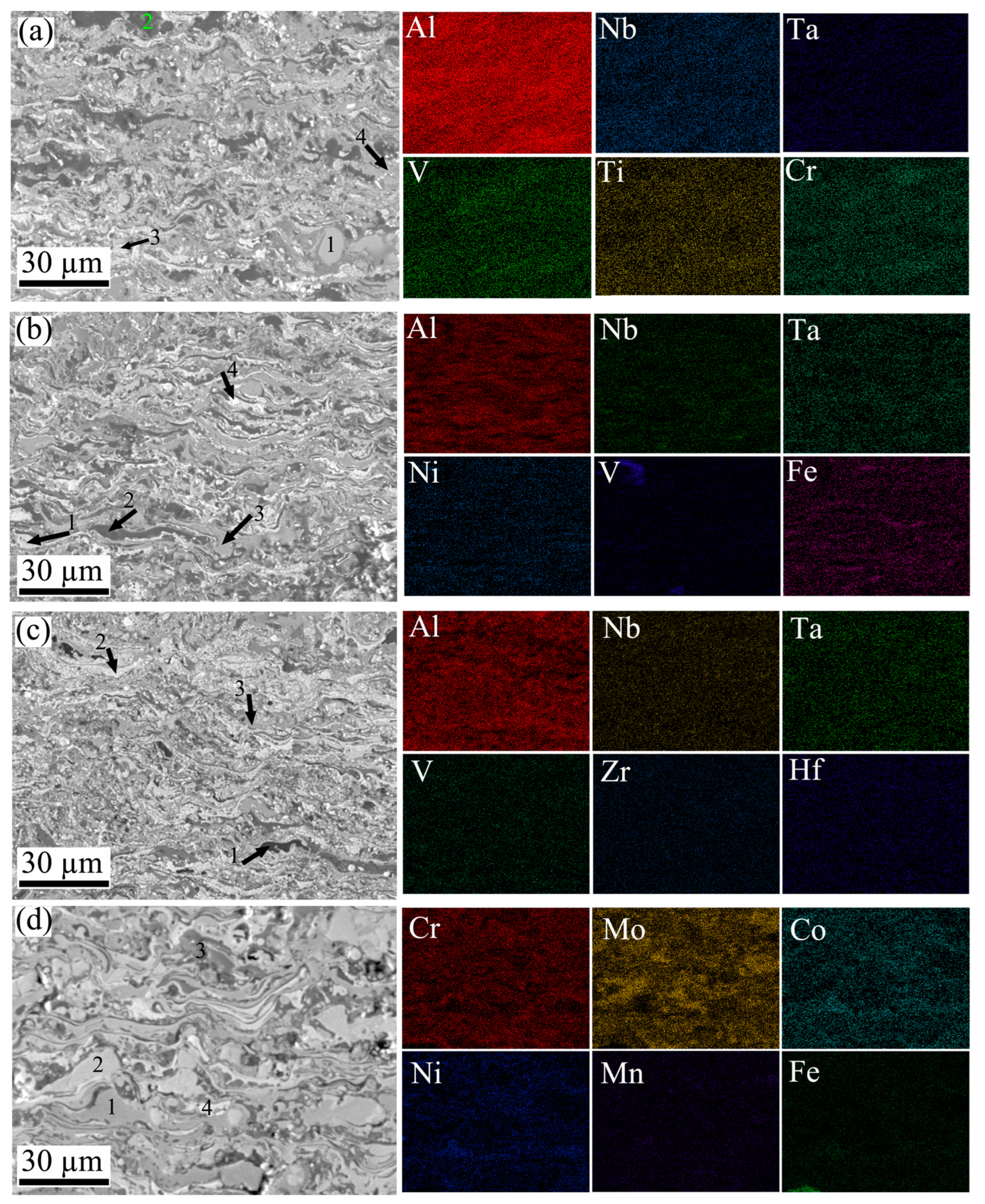
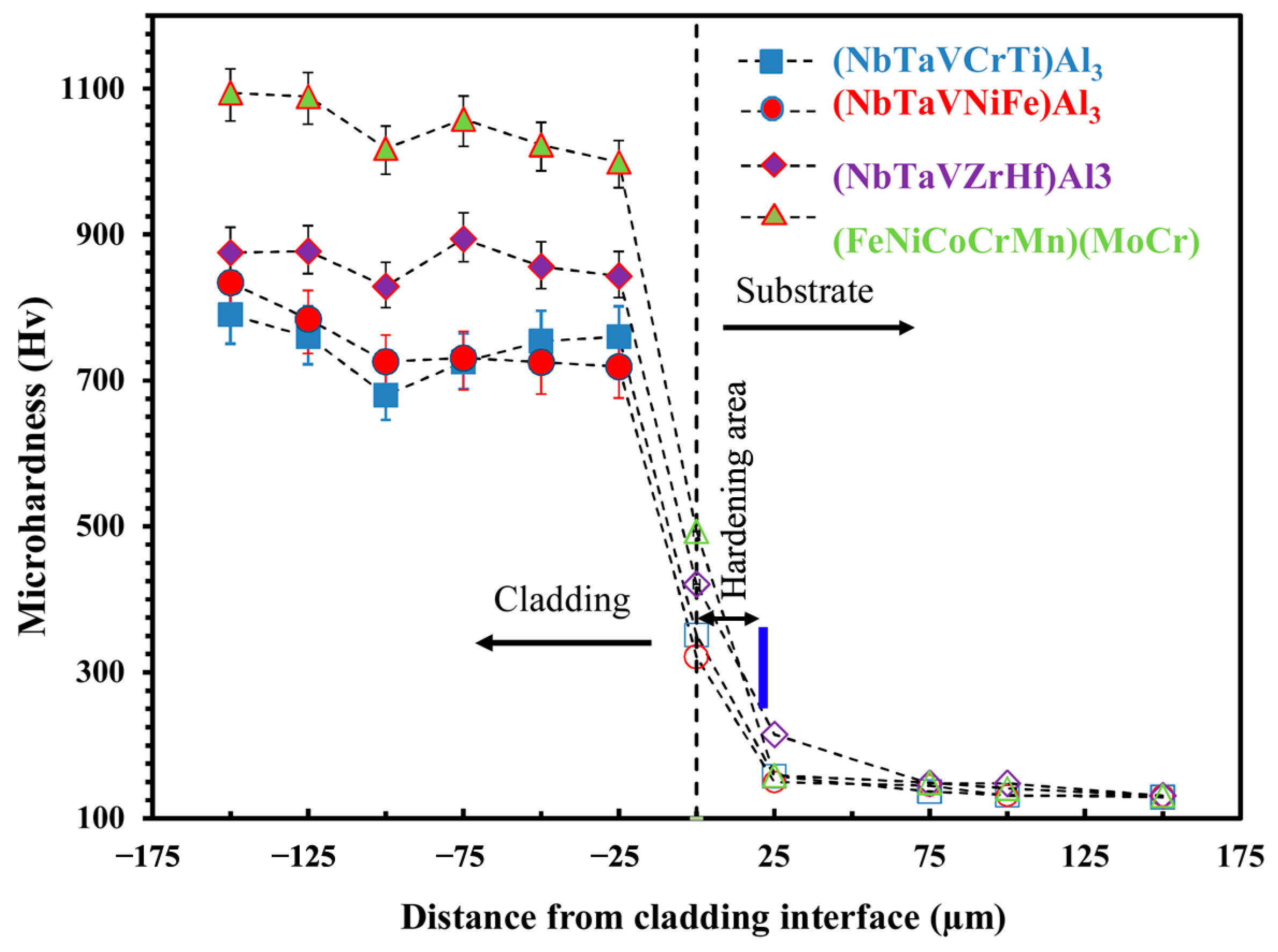
| EDS Chemical Composition (at. %) | ||||||||||||||
|---|---|---|---|---|---|---|---|---|---|---|---|---|---|---|
| HEICs | Al | Nb | Ta | V | Ti | Cr | Zr | Hf | Ni | Fe | Mn | Co | Mo | |
| (NbTaVCrTi)Al3 | D | 73.98 ± 1.2 | 13.63 ± 0.6 | 7.58 ± 0.2 | 1.11 ± 0.03 | 3.10 ± 0.05 | 0.59 ± 0.04 | |||||||
| ID1 | 83.18 ± 1.4 | 0.08 ± 0.01 | 0.11 ± 0.01 | 1.54 ± 0.01 | 0.26 ± 0.03 | 14.83 ± 0.3 | ||||||||
| ID2 | 74.05 ± 1.1 | 0.93 ± 0.02 | 1.63 ± 0.04 | 6.86 ± 0.1 | 5.75 ± 0.2 | 10.78 ± 0.4 | ||||||||
| (NbTaVNiFe)Al3 | D | 73.94 ± 1.2 | 12.05 ± 0.4 | 10.95 ± 0.5 | 2.01 ± 0.01 | 0.35 ± 0.01 | 0.69 ± 0.04 | |||||||
| ID1 | 75.00 ± 0.9 | 0.09 ± 0.01 | 0.09 ± 0.01 | 1.01 ± 0.01 | 5.53 ± 0.1 | 18.27 ± 0.5 | ||||||||
| ID2 | 91.96 ± 1.0 | 0.17 ± 0.04 | 0.12 ± 0.03 | 0.27 ± 0.02 | 0.17 ± 0.03 | 0.11 ± 0.02 | O = 7.20 ± 1.5 | |||||||
| (NbTaVZrHf)Al3 | D | 75.13 ± 0.8 | 5.36 ± 0.2 | 6.37 ± 0.3 | 2.77 ± 0.06 | 5.26 ± 0.2 | 5.11 ± 0.2 | |||||||
| ID1 | 73.81 ± 1.2 | 2.44 ± 0.1 | 2.99 ± 0.1 | 12.09 ± 0.5 | 4.10 ± 0.1 | 4.57 ± 0.1 | ||||||||
| ID2 | 81.58 ± 0.9 | 0.45 ± 0.04 | 1.20 ± 0.02 | 7.17 ± 0.3 | 1.71 ± 0.05 | 2.18 ± 0.1 | O = 5.72 ± 1.3 | |||||||
| (FeNiCoCrMn)(MoCr) | D | 34.65 ± 0.9 | 14.01 ± 0.5 | 11.09 ± 0.4 | 9.51 ± 0.2 | 11.70 ± 0.3 | 19.04 ± 0.6 | |||||||
| ID | 30.35 ± 1.0 | 18.20 ± 0.7 | 10.08 ± 0.1 | 13.31 ± 0.2 | 13.14 ± 0.4 | 14.92 ± 0.5 | ||||||||
| EDS Chemical Composition (at. %) | ||||||||||||||||
|---|---|---|---|---|---|---|---|---|---|---|---|---|---|---|---|---|
| HEICs | Point | Al | Nb | Ta | V | Ti | Cr | Zr | Hf | Ni | Fe | Mn | Co | Mo | O | Por. (%) |
| (NbTaVCrTi)Al3 | 1 | 75.70 ± 1.4 | 12.42 ± 0.7 | 6.06 ± 0.1 | 1.52 ± 0.03 | 3.51 ± 0.06 | 0.80 ± 0.04 | 0.4 | ||||||||
| 2 | 55.22 ± 1.0 | 0.12 ± 0.03 | 0.16 ± 0.01 | 0.05 ± 0.01 | 1.60 ± 0.04 | 0.59 ± 0.03 | 42.26 ± 2.7 | |||||||||
| 3 | 37.42 ± 1.1 | 1.92 ± 0.06 | 1.84 ± 0.02 | 1.72 ± 0.04 | 3.29 ± 0.07 | 2.04 ± 0.1 | 51.76 ± 2.8 | |||||||||
| 4 | 63.84 ± 1.3 | 5.47 ± 0.4 | 6.16 ± 0.3 | 5.11 ± 0.2 | 7.36 ± 0.3 | 7.84 ± 0.7 | 4.22 ± 1.0 | |||||||||
| (NbTaVNiFe)Al3 | 1 | 27.29 ± 1.1 | 11.51 ± 0.4 | 12.66 ± 0.3 | 11.29 ± 0.7 | 19.67 ± 1.5 | 17.60 ± 1.3 | 0.32 | ||||||||
| 2 | 49.03 ± 1.2 | 0.22 ± 0.01 | 0.19 ± 0.02 | 0.27 ± 0.02 | 0.33 ± 0.01 | 0.37 ± 0.07 | 49.59 ± 3.1 | |||||||||
| 3 | 77.23 ± 1.5 | 7.05 ± 0.3 | 4.76 ± 0.2 | 2.49 ± 0.1 | 4.10 ± 0.3 | 4.36 ± 0.2 | ||||||||||
| 4 | 20.03 ± 0.9 | 7.57 ± 0.1 | 20.38 ± 1.1 | 6.39 ± 0.1 | 15.96 ± 1.0 | 7.89 ± 0.5 | 21.79 ± 2.9 | |||||||||
| (NbTaVZrHf)Al3 | 1 | 49.54 ± 1.0 | 0.47 ± 0.03 | 0.49 ± 0.01 | 0.84 ± 0.04 | 0.67 ± 0.05 | 0.89 ± 0.04 | 47.10 ± 2.7 | 0.30 | |||||||
| 2 | 29.32 ± 1.3 | 19.24 ± 0.5 | 17.12 ± 0.7 | 10.62 ± 0.8 | 5.91 ± 0.2 | 4.47 ± 0.2 | 13.32 ± 1.8 | |||||||||
| 3 | 69.36 ± 1.7 | 5.58 ± 0.1 | 4.73 ± 0.2 | 4.50 ± 0.1 | 4.36 ± 0.3 | 4.12 ± 0.1 | 7.36 ± 1.0 | |||||||||
| (FeNiCoCrMn)(MoCr) | 1 | 8.21 ± 0.6 | 34.44 ± 1.4 | 18.71 ± 1.3 | 7.81 ± 0.6 | 24.11 ± 1.4 | 4.28 ± 0.7 | 2.44 ± 0.7 | 0.18 | |||||||
| 2 | 35.76 ± 1.3 | 0.67 ± 0.06 | 4.27 ± 0.2 | 3.35 ± 0.3 | 1.3 ± 0.05 | 54.65 ± 1.76 | ||||||||||
| 3 | 18.64 ± 1.1 | 5.09 ± 0.1 | 5.62 ± 0.3 | 2.57 ± 0.1 | 4.82 ± 0.2 | 9.77 ± 0.7 | 53.49 ± 2.5 | |||||||||
| 4 | 1.67 ± 0.02 | 7.40 ± 0.2 | 2.26 ± 0.1 | 0.3 ± 0.05 | 6.72 ± 0.3 | 53.65 ± 1.2 | 28.01 ± 2.0 | |||||||||
Disclaimer/Publisher’s Note: The statements, opinions and data contained in all publications are solely those of the individual author(s) and contributor(s) and not of MDPI and/or the editor(s). MDPI and/or the editor(s) disclaim responsibility for any injury to people or property resulting from any ideas, methods, instructions or products referred to in the content. |
© 2023 by the authors. Licensee MDPI, Basel, Switzerland. This article is an open access article distributed under the terms and conditions of the Creative Commons Attribution (CC BY) license (https://creativecommons.org/licenses/by/4.0/).
Share and Cite
Ostovari Moghaddam, A.; Sudarikov, M.; Shaburova, N.; Polyakova, M.; Samodurova, M.; Trofimov, E. Microstructural Evolution of High-Entropy Intermetallic Compounds during Detonation Spraying. Metals 2024, 14, 50. https://doi.org/10.3390/met14010050
Ostovari Moghaddam A, Sudarikov M, Shaburova N, Polyakova M, Samodurova M, Trofimov E. Microstructural Evolution of High-Entropy Intermetallic Compounds during Detonation Spraying. Metals. 2024; 14(1):50. https://doi.org/10.3390/met14010050
Chicago/Turabian StyleOstovari Moghaddam, Ahmad, Mikhail Sudarikov, Nataliya Shaburova, Marina Polyakova, Marina Samodurova, and Evgeny Trofimov. 2024. "Microstructural Evolution of High-Entropy Intermetallic Compounds during Detonation Spraying" Metals 14, no. 1: 50. https://doi.org/10.3390/met14010050
APA StyleOstovari Moghaddam, A., Sudarikov, M., Shaburova, N., Polyakova, M., Samodurova, M., & Trofimov, E. (2024). Microstructural Evolution of High-Entropy Intermetallic Compounds during Detonation Spraying. Metals, 14(1), 50. https://doi.org/10.3390/met14010050










